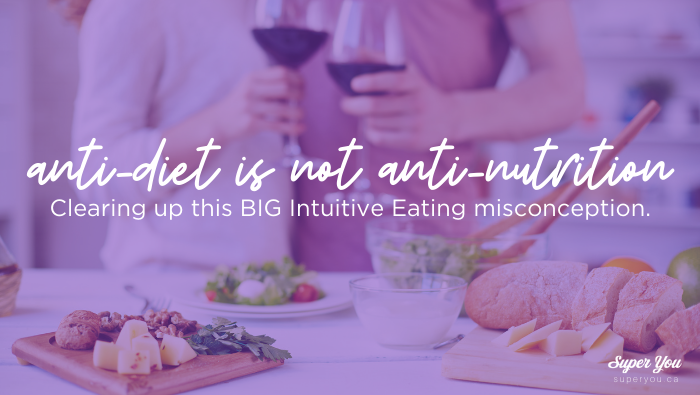One of the biggest misconceptions I hear from people around Intuitive Eating is that it’s a “junk food free-for-all” (aka Anti-Nutrition). The concern is usually phrased something like this:
“If I give myself permission to eat any food I want…I’ll just eat…all the junk food…all. day. long. I’ll never eat healthy food again!”
Maybe you’ve thought the same thing!? In this blog I’m going to clear up this big misconception and get to the heart of what Intuitive Eating really is: an approach to nutrition that is guided by your body, not random rules and Diet Culture judgement.
About that Anti-Nutrition misconception:
I see where this misconception is coming from: it’s principle 3, “Make Peace with Food.” This principle invites you to ditch the random rules (ie. I can eat this/ can’t eat that) and the morality (ie. good/ bad, healthy/junk) you might have around foods and give yourself permission to eat all foods, without worry, rules or judgement.
Why is permission to eat all foods (without judgement) so important?
When we give ourselves permission to have all foods, whenever we want, as much as we want – we take them off their invisible pedestal. They become “just another food.” And over time, with intentional exposures, you realize it’s genuinely no big deal. In some cases – you might even find you don’t like the food that you previously had “no control around.”
The act of permission breathes space into your relationship with all foods. Once you have space around all foods, the foods you previously struggled with are simply not as triggering! It’s a permission paradox.
I can hear your but….”that’ sounds great Gillian, but how do I get there without eating my cupboards bare?! It all feels so scary and uncontrolled!”
I feel you, and I’ve got you. Don’t worry, there’s a process!
The process of making peace: Systematic Habituation.
Some people do go out and get all the foods they’ve restricted and fill their cupboards. And that’s ok! But typically, the permission to eat any food is not a free-for-all, it’s done mindfully and systematically. And it all hinges on a behavioural principle called Habituation.
What is Habituation?
Before I share the coles notes of how it’s done, I want to share a bit more with you about how it works.
Have you ever noticed the left-overs effect? I recently made the most amazing lasagne. It was mouth watering good. And there was lots. Day two the lunch left-overs were epic. Almost better than the first night. But by day 4 of “lasagne for lunch” I was just kinda…done. It wasn’t as good anymore. And it wasn’t because it was gone funny or wasn’t keeping well, it was still good, but I was over it. This is habituation.
And it can literally happen with any food. Even the foods on the “junk food pedestal.”
How does it work?
As I said previously some people like to simply go fill their cupboards and fridge and go for it…or purchase/ have foods when they’re inspired… intuitively. But for many this is way too scary and overwhelming (it’s ok if you feel that way too!).
The process can look a lot of different ways (as your coach, I help you figure out just how to do it). It usually starts by making a list of all the foods you feel triggered by. From there you might even categorize the list by degree – which ones are the most or least intimidating to explore? Some people like to tackle the “big ones” first, others like to lean in with ones that aren’t so scary. But there is no one “right way” (notice a theme?).
From here you explore the environment that is most conducive to you being successful in your exposure to this food. It might be out or at home. It might be buying a single serving or more. There might be a specific day or time of day that feels best. Whichever way you choose to do it (again, this is where coaching can be helpful), the process of exposure looks similar.
- You sit mindfully and present with the food. You notice it. Like, really notice it. You embrace all your senses: sight, touch, smell, sound, and of course taste! S L O W L Y experience the food and check in along the way to notice how you’re doing. You stop when you’re ready.
- This is best done when you’re not terribly hungry, nor terribly full (ie. between satisfying meals).
- You might need to do this more than once with the same food, or more than once within a “category” of food (say going through more than one flavour of ice cream or brand of chocolate).
- Some people only need to tackle a few of the foods on their list, others will work their way through the whole list. No matter how you do it, at some point it’ll “click.” You’ll begin to realize that all these “off limits” foods aren’t actually that big a deal, hello #foodfreedom
What’s the result?
Once you break free from the random rules that are controlling your intake, you can relax around foods. You can genuinely make space for all foods within your approach to nutrition. You can have your favourite treat (or “play” foods as we call them) without feeling like you’ve done in your day or need a clean slate. Which also means you’re not likely to get into “last supper eating” where you eat everything and anything because “tomorrow is a clean slate.” I know, it is like I’m reading your mind. I get it. I’ve been there!
In combination with increased practice around honouring your hunger you’ll find more ease around these foods and all foods. You’ll come to realize that your “lack of control” was less about you being “addicted to –fill in the blank food–” (FYI this is not a thing) and more about your body responding to restriction (both in quantity and quality of foods).
Side note: did you know that when you under-eat your body is physiologically primed to push you to eat – with a significant intensity. You might have noticed this when you’re on a diet. You’re “on track all day” and then you end up in a wild and out of control “binge.” This is likely not an actual binge behaviour, but rather something we call Primal Hunger. It’s why we tackle “Honouring your Hunger” first, then “Make Peace with Food.”
As you release restriction, honour your hunger and make peace with food (for real) you’ll find a space of food freedom that is not only joyful, but also healthy!
But what if there are foods that don’t work for my body? Do I have to eat at those? Aren’t some rules good?!
Oy, loaded question. Let me tackle it one step at a time.
Should you eat foods that don’t work for your body?
Absolutely not! This is the literal point of Intuitive Eating. It’s about intuitively trusting your body to communicate with you, and you listening and being respectful towards those signals.
For example…
For years I’ve known that dairy and I don’t mix well. When I have too much I get kinda mucousy and don’t feel great.Generally speaking I don’t eat much dairy as a result. This isn’t a random diet rule – this is me being respectful towards my body. Does that mean I never have dairy? Nope. Sometimes I run a cost/ benefit analysis (ie. feeling gross vs. culinary satisfaction) and I determine…it’s worth it. Sometimes my evaluation is correct, and sometimes it’s not. And both are learning opportunities between my body and I.
I’m also celiac. Which means I have a significant autoimmune response to gluten (found in wheat, barley and other grains). As a rule I don’t eat gluten. Because my body has a negative physiologic response to these foods (like an allergy). This rule isn’t arbitrary. It’s based on my genetic make-up.
So, some rules are good?!
This is where the question gets tricky…within the more modern “wellness diet” or “it’s a lifestyle” trends in dieting there are a LOT of foods that have been demonized (carbs, sugar, non-organics, grains…etc.). In many cases your body may be absolutely fine with these foods, and the rule is arbitrary. In other cases (like the personal examples I listed above, they may be legit).
For me a hard line around gluten is an important and healthful “rule.” If you’re not celiac that isn’t true. The “trick” is to start to weed out the arbitrary and peacefully connect with your own body autonomy.
Intuitive Eating ditches arbitrary for autonomy.
Within this framework, you’re the queen (or king) of your body. Your body is your business. It’s up to you (and only you) how you choose to nourish it. Period. As you bet better at tuning into your hunger (principle 2), feeling your fullness (principle 6) and respecting your body (principle 8) you’ll find you innately, naturally, intuitively eat in a way that serves you.
But what about macros, micros and calories?
Don’t I need to pay attention to these? For health?! YES…and NO.
So here’s the other thing, Intuitive Eating is not negating nutritional principles, far from it! It’s a framework to guide and encourage a healthy relationship around all foods so you can truly listen to your body and respond respectfully to it’s unique nutritional needs! It recognizes that if we tune in and listen, and develop our interoceptive awareness (our ability to sense our body) we can actually tune into what our needs are.
It’s like a big old experiment. With time you can peacefully explore different nutritional principles in a way that works for you. You can be mindful of your macros (proteins, fats and carbs) and look at how your body responds to them. For example, I find I feel my best when I have some protein at most meals and snacks. Meals and snacks “stick” with me longer this way. I also notice I feel my best when many (but not all) of these protein sources are plant based. This isn’t a rule, but me responding, respectfully to how my body feels.
The bottom line:
Without all the noise of Diet Culture (we reject that in Principle 1), and with the new-found tools and reclaimed body awareness as we honour our hunger (principle 2), we make space for Gentle Nutrition (principle 10). We can focus on the quality of the foods we choose not as a measure of their “moral value” as ascribed by Diet Culture, but by measure of how they make our bodies feel! We more naturally shift into an easy relationship with food and nutritional principles grounded in science, common sense and body wisdom. And all that time, energy and money you used to spend on dieting and food obsession? You can re-allocate it to living your one, precious, brilliant life!
Sound amazing?! Want to dig in? I’d love to support you! I’m currently taking one-to-one clients for Intuitive Eating Coaching. If you’re more of a self-directed learner, you can also check out my virtual Intuitive Eating Course! Bottom line: there are lots of ways to explore! Let me know if you have any questions!

